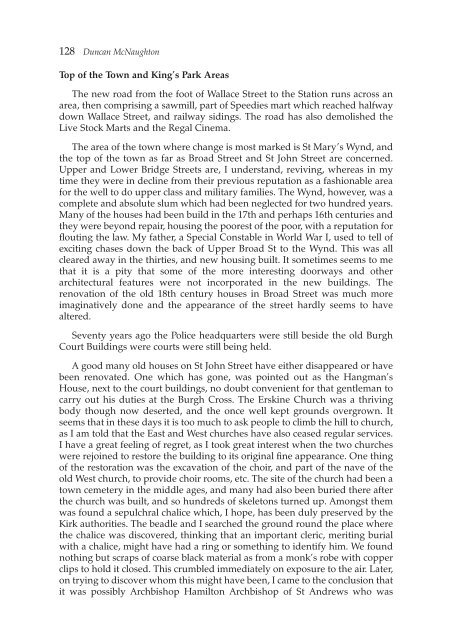the Forth Naturalist Historian - Forth Naturalist and Historian ...
the Forth Naturalist Historian - Forth Naturalist and Historian ...
the Forth Naturalist Historian - Forth Naturalist and Historian ...
Create successful ePaper yourself
Turn your PDF publications into a flip-book with our unique Google optimized e-Paper software.
128 Duncan McNaughton<br />
Top of <strong>the</strong> Town <strong>and</strong> King’s Park Areas<br />
The new road from <strong>the</strong> foot of Wallace Street to <strong>the</strong> Station runs across an<br />
area, <strong>the</strong>n comprising a sawmill, part of Speedies mart which reached halfway<br />
down Wallace Street, <strong>and</strong> railway sidings. The road has also demolished <strong>the</strong><br />
Live Stock Marts <strong>and</strong> <strong>the</strong> Regal Cinema.<br />
The area of <strong>the</strong> town where change is most marked is St Mary’s Wynd, <strong>and</strong><br />
<strong>the</strong> top of <strong>the</strong> town as far as Broad Street <strong>and</strong> St John Street are concerned.<br />
Upper <strong>and</strong> Lower Bridge Streets are, I underst<strong>and</strong>, reviving, whereas in my<br />
time <strong>the</strong>y were in decline from <strong>the</strong>ir previous reputation as a fashionable area<br />
for <strong>the</strong> well to do upper class <strong>and</strong> military families. The Wynd, however, was a<br />
complete <strong>and</strong> absolute slum which had been neglected for two hundred years.<br />
Many of <strong>the</strong> houses had been build in <strong>the</strong> 17th <strong>and</strong> perhaps 16th centuries <strong>and</strong><br />
<strong>the</strong>y were beyond repair, housing <strong>the</strong> poorest of <strong>the</strong> poor, with a reputation for<br />
flouting <strong>the</strong> law. My fa<strong>the</strong>r, a Special Constable in World War I, used to tell of<br />
exciting chases down <strong>the</strong> back of Upper Broad St to <strong>the</strong> Wynd. This was all<br />
cleared away in <strong>the</strong> thirties, <strong>and</strong> new housing built. It sometimes seems to me<br />
that it is a pity that some of <strong>the</strong> more interesting doorways <strong>and</strong> o<strong>the</strong>r<br />
architectural features were not incorporated in <strong>the</strong> new buildings. The<br />
renovation of <strong>the</strong> old 18th century houses in Broad Street was much more<br />
imaginatively done <strong>and</strong> <strong>the</strong> appearance of <strong>the</strong> street hardly seems to have<br />
altered.<br />
Seventy years ago <strong>the</strong> Police headquarters were still beside <strong>the</strong> old Burgh<br />
Court Buildings were courts were still being held.<br />
A good many old houses on St John Street have ei<strong>the</strong>r disappeared or have<br />
been renovated. One which has gone, was pointed out as <strong>the</strong> Hangman’s<br />
House, next to <strong>the</strong> court buildings, no doubt convenient for that gentleman to<br />
carry out his duties at <strong>the</strong> Burgh Cross. The Erskine Church was a thriving<br />
body though now deserted, <strong>and</strong> <strong>the</strong> once well kept grounds overgrown. It<br />
seems that in <strong>the</strong>se days it is too much to ask people to climb <strong>the</strong> hill to church,<br />
as I am told that <strong>the</strong> East <strong>and</strong> West churches have also ceased regular services.<br />
I have a great feeling of regret, as I took great interest when <strong>the</strong> two churches<br />
were rejoined to restore <strong>the</strong> building to its original fine appearance. One thing<br />
of <strong>the</strong> restoration was <strong>the</strong> excavation of <strong>the</strong> choir, <strong>and</strong> part of <strong>the</strong> nave of <strong>the</strong><br />
old West church, to provide choir rooms, etc. The site of <strong>the</strong> church had been a<br />
town cemetery in <strong>the</strong> middle ages, <strong>and</strong> many had also been buried <strong>the</strong>re after<br />
<strong>the</strong> church was built, <strong>and</strong> so hundreds of skeletons turned up. Amongst <strong>the</strong>m<br />
was found a sepulchral chalice which, I hope, has been duly preserved by <strong>the</strong><br />
Kirk authorities. The beadle <strong>and</strong> I searched <strong>the</strong> ground round <strong>the</strong> place where<br />
<strong>the</strong> chalice was discovered, thinking that an important cleric, meriting burial<br />
with a chalice, might have had a ring or something to identify him. We found<br />
nothing but scraps of coarse black material as from a monk’s robe with copper<br />
clips to hold it closed. This crumbled immediately on exposure to <strong>the</strong> air. Later,<br />
on trying to discover whom this might have been, I came to <strong>the</strong> conclusion that<br />
it was possibly Archbishop Hamilton Archbishop of St Andrews who was



